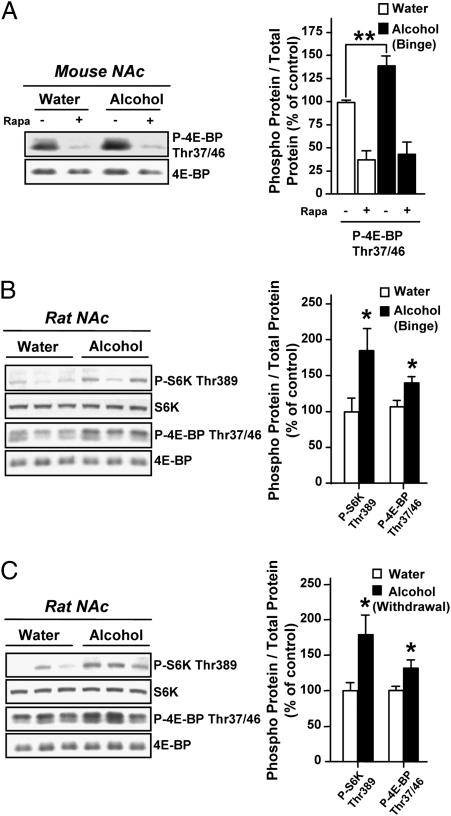Fig. 3.
Excessive alcohol consumption activates the mTORC1-mediated signaling pathway in the NAc of rodents. (A) C57BL/6J mice had access to a 20% solution of alcohol for 4 h every other day for 3 wk. Three hours before the tenth 4-h alcohol-drinking session, mice were treated (i.p.) with vehicle or 20 mg/kg of rapamycin (Rapa), and the NAc were removed immediately after the alcohol-drinking session (n = 8 per group). Two-way ANOVA showed a significant main effect of the fluid [water or alcohol; F(1,28) = 5.27, P < 0.05] and treatment [Veh or rapamycin; F(1,28) = 63.26, P < 0.001] but no interaction [F(1,28) = 2.86, P = 0.10]. Subsequent analysis using the method of contrasts detected a significant difference between water and alcohol within the vehicle group (**P < 0.01) but not within the rapamycin group. The level of 4E-BP phosphorylation was determined by Western blot (the level of S6K phosphorylation was too low to be accurately quantified). (B and C) Rats experienced at least 3 mo of intermittent-access 20% alcohol two-bottle choice drinking sessions. Control animals underwent the same paradigms but did not have access to alcohol. (B) After the last 24 h of alcohol deprivation, rats had access to a 20% solution of alcohol for 30 min, leading to an average intake of 1.16 ± 0.06 g/kg, and the NAc were immediately removed. (C) The NAc were removed after the last 24 h of alcohol deprivation session (withdrawal). The levels of S6K and 4E-BP phosphorylation were determined by Western blot (n = 9 per group in B and C). Data are presented as mean ± SEM and expressed as percentage of control; *P < 0.05, two-tailed unpaired t test.

